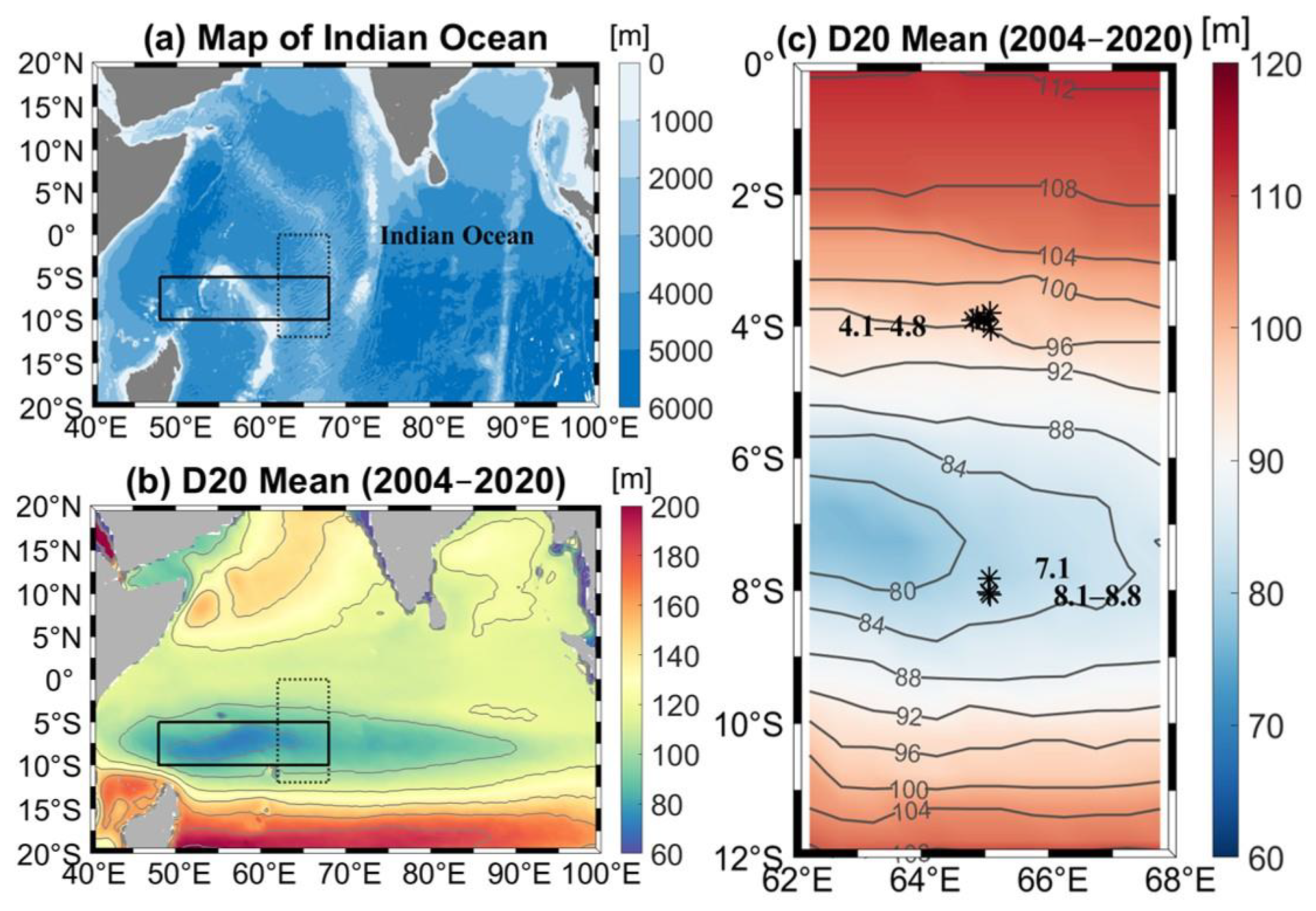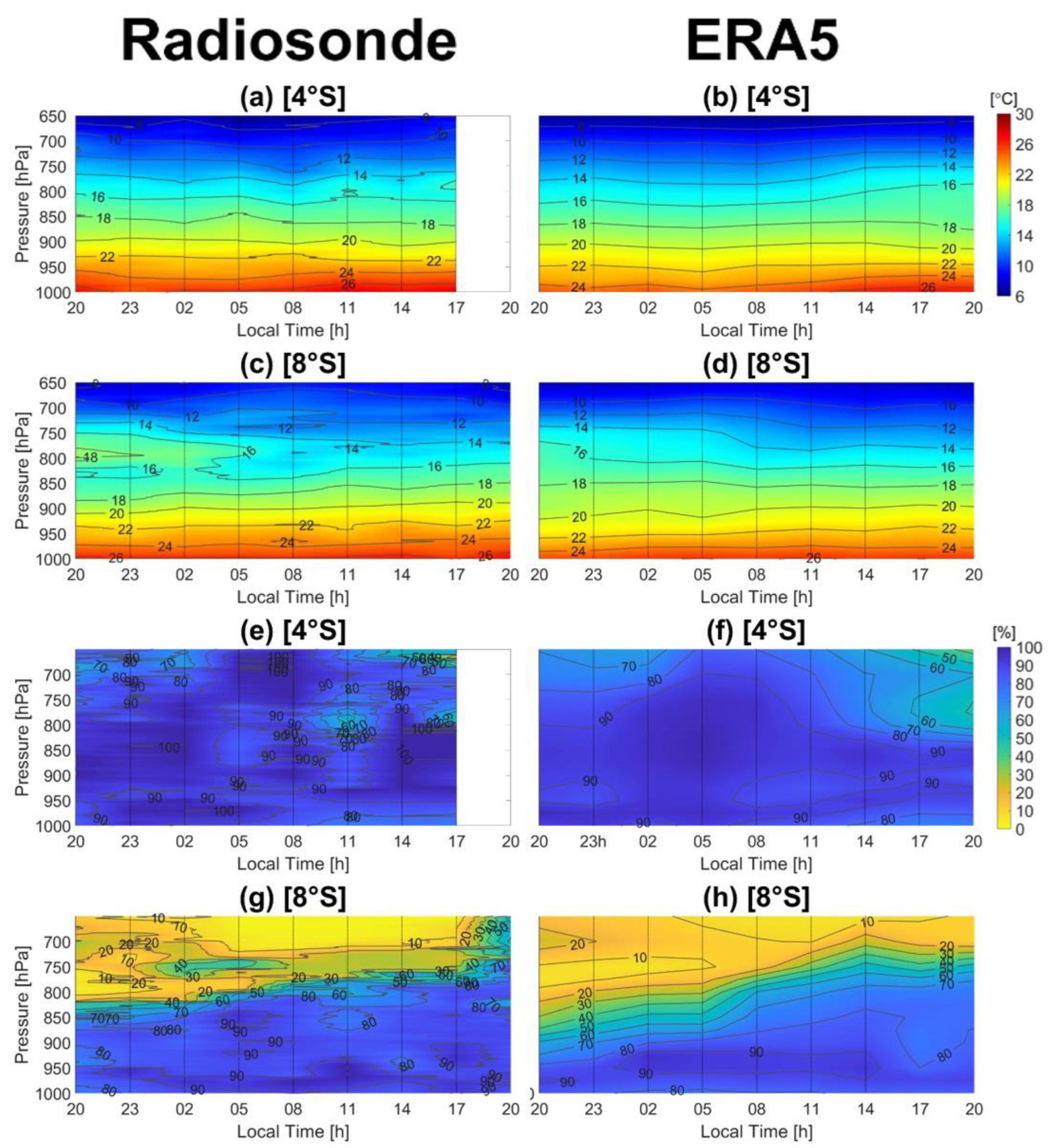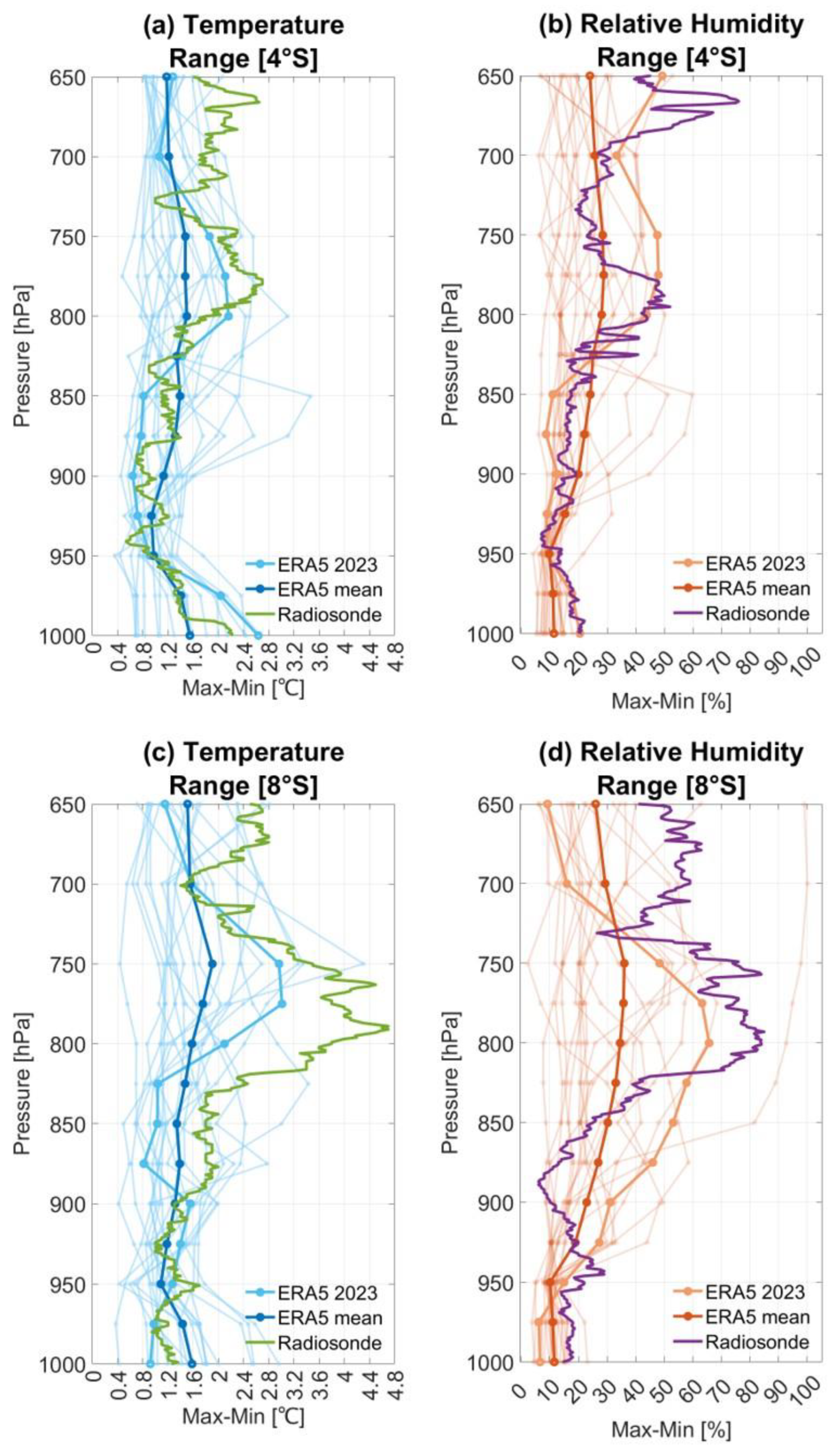Underestimation of Diurnal Variations in ERA5 Temperature and Relative Humidity over Tropical Indian Ocean
Abstract
1. Introduction
2. Materials and Methods
2.1. Radiosonde Observation
2.2. ERA5
2.3. Simple Ocean Data Assimilation
3. Results
3.1. Comparison of Diurnal Variation (Radiosonde Observation vs. ERA5)
3.2. Comparison of Diurnal Ranges (Radiosonde Observation vs. ERA5)
4. Discussion and Conclusions
Author Contributions
Funding
Institutional Review Board Statement
Informed Consent Statement
Data Availability Statement
Acknowledgments
Conflicts of Interest
References
- Dai, A. The diurnal cycle from observations and ERA5 in precipitation, clouds, boundary layer height, buoyancy, and surface fluxes. Clim. Dyn. 2024, 62, 5879–5908. [Google Scholar]
- Dai, A. The diurnal cycle from observations and ERA5 in surface pressure, temperature, humidity, and winds. Clim. Dyn. 2023, 61, 2965–2990. [Google Scholar] [CrossRef]
- Mapes, B.E.; Warner, T.T.; Xu, M.; Negri, A.J. Diurnal patterns of rainfall in northwestern South America. Part I: Observations and context. Mon. Weather Rev. 2003, 131, 799–812. [Google Scholar]
- Johnson, R.H.; Rickenbach, T.M.; Rutledge, S.A.; Ciesielski, P.E.; Schubert, W.H. Trimodal characteristics of tropical convection. J. Clim. 1999, 12, 2397–2418. [Google Scholar]
- Mapes, B.E.; Warner, T.T.; Xu, M. Diurnal patterns of rainfall in northwestern South America. Part III: Diurnal gravity waves and nocturnal convection offshore. Mon. Weather Rev. 2003, 131, 830–844. [Google Scholar] [CrossRef]
- Soden, B.J. The diurnal cycle of convection, clouds, and water vapor in the tropical upper troposphere. Geophys. Res. Lett. 2000, 27, 2173–2176. [Google Scholar] [CrossRef]
- Hayden, L.J.; Tan, J.; Bolvin, D.T.; Huffman, G.J. Variations in the diurnal cycle of precipitation and its changes with distance from shore over two contrasting regions as observed by IMERG, ERA5, and Spaceborne Ku Radar. J. Hydrometeo. 2023, 24, 675–689. [Google Scholar] [CrossRef]
- Hendon, H.H.; Woodberry, K. The diurnal cycle of tropical convection. J. Geophys. Res. Atmos. 1993, 98, 16623–16637. [Google Scholar] [CrossRef]
- Woodberry, K.E.; Luther, M.E.; O’Brien, J.J. The Wind-driven seasonal circulation in the Southern Tropical Indian Ocean. J. Geophys. Res. Ocean. 1989, 94, 17985–18002. [Google Scholar] [CrossRef]
- McCreary, J.P.; Kundu, P.K.; Molinari, R.L. A numerical investigation of dynamics, thermodynamics and mixed-layer processes in the Indian Ocean. Prog. Oceano. 1993, 31, 181–244. [Google Scholar]
- Schott, F.A.; Xie, S.; McCreary, J.P. Indian Ocean Circulation and climate variability. Rev. Geophys. 2009, 47, 2007RG000245. [Google Scholar]
- Yokoi, T.; Tozuka, T.; Yamagata, T. Seasonal variation of the Seychelles Dome. J. Clim. 2008, 21, 3740–3754. [Google Scholar]
- Xie, S.P.; Annamalai, H.; Schott, F.A.; McCreary, J.P. Structure and mechanisms of South Indian Ocean climate variability. J. Clim. 2002, 15, 864–878. [Google Scholar] [CrossRef]
- Masumoto, Y.; Meyers, G. Forced Rossby waves in the southern tropical Indian Ocean. J. Geophys. Res. Ocean. 1998, 103, 27589–27602. [Google Scholar] [CrossRef]
- Lee, E.; Kim, C.; Na, H. Suppressed upwelling events in the Seychelles–Chagos Thermocline Ridge of the Southwestern Tropical Indian Ocean. Ocean Sci. J. 2022, 57, 305–313. [Google Scholar]
- Hersbach, H.; Bell, B.; Berrisford, P.; Hirahara, S.; Horányi, A.; Muñoz-Sabater, J.; Nicolas, J.; Peubey, C.; Radu, R.; Schepers, D.; et al. The ERA5 global reanalysis. Q. J. R. Meteorol. Soc. 2020, 146, 1999–2049. [Google Scholar]
- Carton, J.A.; Chepurin, G.A.; Chen, L. SODA3: A new ocean climate reanalysis. J. Clim. 2018, 31, 6967–6983. [Google Scholar] [CrossRef]



| Station | Sites | Latitude (°S) | Longitude (°E) | Date and Time (YYYY-MM-DD HH) |
|---|---|---|---|---|
| 4 | 4.1 | 4.046 | 65.097 | 2023-05-31 20 |
| 4.2 | 3.906 | 64.803 | 2023-05-31 23 | |
| 4.3 | 3.801 | 65.078 | 2023-06-01 02 | |
| 4.4 | 3.876 | 64.883 | 2023-06-01 05 | |
| 4.5 | 3.966 | 64.983 | 2023-06-01 08 | |
| 4.6 | 3.872 | 64.985 | 2023-06-01 11 | |
| 4.7 | 3.893 | 64.984 | 2023-06-01 14 | |
| 4.8 | 3.927 | 64.984 | 2023-06-01 17 | |
| 8 | 8.1 | 8.026 | 65.062 | 2023-05-28 20 |
| 8.2 | 8.067 | 65.083 | 2023-05-28 23 | |
| 8.3 | 8.067 | 65.083 | 2023-05-29 02 | |
| 8.4 | 8.067 | 65.083 | 2023-05-29 05 | |
| 8.5 | 8.067 | 65.083 | 2023-05-29 08 | |
| 8.6 | 8.067 | 65.083 | 2023-05-29 11 | |
| 8.7 | 8.067 | 65.083 | 2023-05-29 14 | |
| 8.8 | 8.067 | 65.083 | 2023-05-29 17 | |
| 7.1 | 7.816 | 65.068 | 2023-05-29 20 |
Disclaimer/Publisher’s Note: The statements, opinions and data contained in all publications are solely those of the individual author(s) and contributor(s) and not of MDPI and/or the editor(s). MDPI and/or the editor(s) disclaim responsibility for any injury to people or property resulting from any ideas, methods, instructions or products referred to in the content. |
© 2025 by the authors. Licensee MDPI, Basel, Switzerland. This article is an open access article distributed under the terms and conditions of the Creative Commons Attribution (CC BY) license (https://creativecommons.org/licenses/by/4.0/).
Share and Cite
Park, J.; Na, H.; Lee, E. Underestimation of Diurnal Variations in ERA5 Temperature and Relative Humidity over Tropical Indian Ocean. Atmosphere 2025, 16, 404. https://doi.org/10.3390/atmos16040404
Park J, Na H, Lee E. Underestimation of Diurnal Variations in ERA5 Temperature and Relative Humidity over Tropical Indian Ocean. Atmosphere. 2025; 16(4):404. https://doi.org/10.3390/atmos16040404
Chicago/Turabian StylePark, Jeongwook, Hanna Na, and Eunsun Lee. 2025. "Underestimation of Diurnal Variations in ERA5 Temperature and Relative Humidity over Tropical Indian Ocean" Atmosphere 16, no. 4: 404. https://doi.org/10.3390/atmos16040404
APA StylePark, J., Na, H., & Lee, E. (2025). Underestimation of Diurnal Variations in ERA5 Temperature and Relative Humidity over Tropical Indian Ocean. Atmosphere, 16(4), 404. https://doi.org/10.3390/atmos16040404






